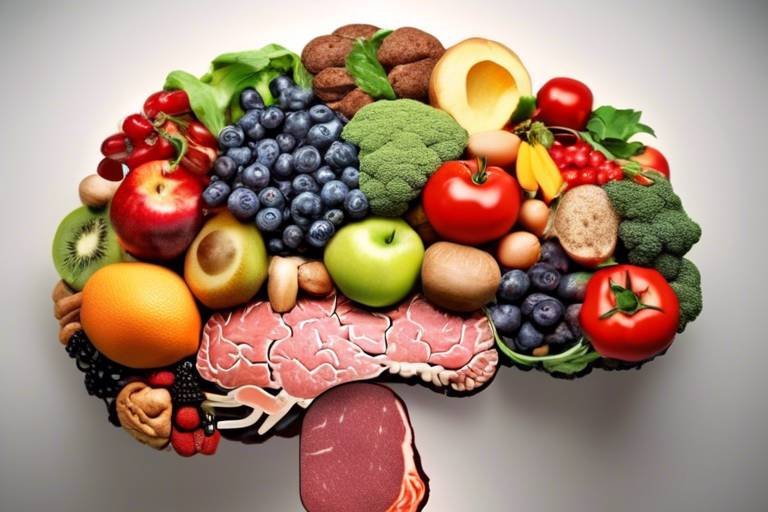Introducing Foods to Your Baby: Allergies and Intolerances
Introducing solid foods to your baby is an exciting milestone, but it can also be a bit daunting, especially when you consider the potential for allergies and intolerances. As a parent, you want to ensure that your little one has a safe and healthy start to their dietary journey. This article dives deep into the critical aspects of this process, helping you navigate through the world of baby foods while keeping an eye out for any adverse reactions. With the right knowledge at your disposal, you can confidently introduce new flavors and textures to your baby's palate, all while minimizing the risks associated with food allergies and intolerances.
Food allergies can be quite common in infants, and understanding them is essential for every parent. A food allergy occurs when the immune system mistakenly identifies a harmless food protein as a threat, prompting a reaction. Some of the most common allergens include milk, eggs, peanuts, tree nuts, soy, wheat, fish, and shellfish. The symptoms of food allergies can vary significantly from one child to another, making it crucial for parents to be vigilant. Early recognition can lead to better management and a more comfortable experience for your baby.
While food allergies involve the immune system, food intolerances are generally digestive issues that occur when the body cannot properly break down certain foods. Common intolerances in babies include lactose intolerance and gluten sensitivity. Unlike allergies, intolerances typically do not involve the immune system, and while they can cause discomfort, they are often less severe. Understanding the difference between these two can help you navigate your baby's dietary needs more effectively.
Recognizing the signs of food allergies in babies is crucial for timely intervention. Symptoms can manifest in various ways, and being aware of them can make a significant difference. Common signs to look out for include:
- Skin Reactions: Rashes, hives, or eczema flare-ups can be indicators of an allergic reaction.
- Gastrointestinal Symptoms: Vomiting, diarrhea, or abdominal pain may suggest food intolerances or allergies.
- Respiratory Issues: Wheezing, coughing, or difficulty breathing can also signal an allergic reaction.
Skin reactions such as hives or eczema are common indicators of food allergies in infants. These can appear shortly after consuming a new food. If you notice any unusual skin changes, it’s essential to take note of what your baby ate prior to the reaction. In some cases, these reactions can be mild and temporary, but in others, they may require medical attention. Always consult your pediatrician if you have concerns.
Gastrointestinal symptoms can be tricky because babies often experience tummy troubles. However, if your baby has persistent vomiting or diarrhea after trying new foods, it could be a sign of an allergy or intolerance. Pay close attention to the timing and frequency of these symptoms. If they seem excessive or are accompanied by other signs, such as fever or lethargy, seek medical advice.
Understanding how to test for food allergies is essential for parents. If you suspect your baby has a food allergy, your pediatrician may recommend various testing methods, including:
- Skin Prick Tests: Small amounts of allergens are applied to the skin to see if a reaction occurs.
- Blood Tests: These tests measure the immune system's response to specific foods.
These tests can help confirm whether your baby has a food allergy and guide you on the next steps.
When it comes to introducing solid foods, timing and approach are everything. The American Academy of Pediatrics recommends starting solids around six months of age. It’s crucial to introduce new foods one at a time, waiting a few days before introducing another. This allows you to monitor for any adverse reactions. Additionally, consider starting with iron-rich foods, such as pureed meats or iron-fortified cereals, which are beneficial for your baby's growth.
Choosing the right first foods can set the stage for a healthy diet. Here are some safe options to consider:
- Single-Grain Cereals: Start with rice or oatmeal cereal mixed with breast milk or formula.
- Pureed Vegetables: Sweet potatoes, carrots, and peas are great choices.
- Pureed Fruits: Apples, bananas, and avocados are nutritious and easy to digest.
These foods not only provide essential nutrients but also help your baby get used to different textures.
Monitoring your baby's reactions to new foods is vital for ensuring their safety. Keeping a food diary can be incredibly helpful. Note down what foods you introduce, along with any reactions observed. Look for signs such as:
- Changes in behavior or mood
- Physical signs like rashes or gastrointestinal upset
- Any unusual symptoms that arise after eating
This proactive approach allows you to identify patterns and consult healthcare professionals if needed.
1. At what age should I start introducing solid foods to my baby?
The general recommendation is to start introducing solid foods around six months of age, but it's essential to consult your pediatrician for personalized advice.
2. How can I tell if my baby has a food allergy?
Watch for symptoms like rashes, gastrointestinal issues, or respiratory problems after introducing new foods. If you suspect an allergy, consult your pediatrician.
3. What should I do if my baby has an allergic reaction?
If your baby shows signs of a severe allergic reaction, such as difficulty breathing or swelling, seek emergency medical help immediately.
4. Can I give my baby common allergens like peanuts or eggs?
Yes, recent guidelines suggest introducing common allergens like peanuts and eggs early on, around six months, to reduce the risk of developing allergies. However, consult your pediatrician first.
5. How can I safely introduce new foods?
Introduce one new food at a time, waiting a few days before adding another. This allows you to monitor for any allergic reactions effectively.

Understanding Baby Allergies
When it comes to introducing solid foods to your little one, is crucial. As a parent, you want to ensure that your baby’s first experiences with food are not only delightful but also safe. Food allergies can manifest in various ways, and being aware of the common culprits can help you navigate this exciting yet challenging phase. Did you know that as many as 6-8% of children under three years old may have food allergies? This statistic should definitely grab your attention!
Food allergies occur when the immune system mistakenly identifies a harmless food protein as a threat. This can lead to a range of reactions, from mild to severe. The most common food allergens for infants include:
- Milk
- Eggs
- Peanuts
- Tree nuts
- Fish
- Shellfish
- Wheat
- Soy
Recognizing these allergens early can make a significant difference in your baby’s health. Symptoms of food allergies can vary widely, ranging from skin reactions like hives to gastrointestinal issues such as vomiting or diarrhea. If you notice any unusual symptoms after introducing a new food, it’s essential to consult your pediatrician promptly.
Now, you might be wondering, “How do I know if my baby has an allergy?” Well, it’s all about observation and awareness. Keeping a close eye on your baby’s reactions after each new food introduction can help you spot any potential issues. If you notice persistent symptoms, it may be time to consider allergy testing.
In the next sections, we’ll delve deeper into recognizing the signs of food allergies and how to test for them. Remember, early detection is key! The sooner you identify a potential allergy, the better you can manage your baby's diet and ensure they have a healthy start in life.

Common Food Intolerances
When it comes to feeding your little one, understanding food intolerances is just as important as recognizing allergies. While food allergies can trigger severe reactions, intolerances often lead to discomfort without the immune system going into overdrive. This distinction is crucial for parents navigating the complex world of infant nutrition. So, what exactly are these intolerances? They occur when a baby’s digestive system struggles to break down certain foods, leading to a range of symptoms that can be both confusing and concerning.
Some of the most common food intolerances in infants include lactose intolerance and gluten sensitivity. Lactose intolerance happens when a baby lacks the enzyme lactase, which is needed to digest lactose, the sugar found in milk. This can result in symptoms like bloating, gas, and diarrhea after consuming dairy products. On the other hand, gluten sensitivity, which is often confused with celiac disease, can cause similar gastrointestinal distress when a baby consumes foods containing gluten, such as wheat, barley, and rye.
It's important to note that food intolerances can sometimes mimic food allergies, making it difficult for parents to identify the root cause of their baby's discomfort. For instance, if your baby experiences frequent tummy troubles or skin irritations after trying a new food, it might not be an allergic reaction but rather an intolerance. Keeping a close eye on your baby's reactions to different foods can help you pinpoint potential intolerances.
Here’s a quick overview of some common food intolerances in infants:
| Food Intolerance | Symptoms |
|---|---|
| Lactose Intolerance | Bloating, gas, diarrhea |
| Gluten Sensitivity | Abdominal pain, bloating, diarrhea |
| Fructose Malabsorption | Gas, bloating, diarrhea |
| Food Additive Sensitivity | Headaches, stomach cramps, irritability |
Recognizing these symptoms early can make a world of difference in managing your baby’s diet effectively. If you suspect your baby has a food intolerance, it’s best to consult with a pediatrician or a nutritionist who specializes in infant diets. They can guide you on the appropriate steps to take, which may include eliminating certain foods from your baby’s diet and gradually reintroducing them to monitor reactions.
In summary, while food intolerances may not pose the same level of risk as allergies, they can still significantly impact your baby's comfort and well-being. By staying informed and observant, you can help ensure that your baby has a positive experience with solid foods, paving the way for a healthy relationship with food as they grow.
- What are the signs of food intolerance in infants? Look for symptoms such as bloating, gas, diarrhea, or irritability after feeding.
- How can I differentiate between a food allergy and intolerance? Allergies typically trigger immediate immune responses, while intolerances often result in digestive discomfort.
- Should I eliminate certain foods from my baby's diet? If you suspect a food intolerance, consult your pediatrician before making any dietary changes.

Signs of Food Allergies
Recognizing the signs of food allergies in babies is crucial for their health and well-being. As a parent, you might be wondering, "How do I know if my little one is having an allergic reaction?" The truth is, babies can’t vocalize their discomfort, so it’s up to you to be vigilant. Allergic reactions can manifest in various ways, and understanding these signs can help you respond swiftly and appropriately.
One of the most common indicators of a food allergy is the appearance of skin reactions. These can include hives, which are raised, itchy welts on the skin, or eczema, a condition that causes red, inflamed patches. If you notice any unusual skin changes shortly after introducing a new food, it’s essential to take note and consult your pediatrician. Skin reactions can be alarming, but they are often the body’s way of signaling that something isn’t right.
Another area to monitor is your baby’s gastrointestinal health. Symptoms such as vomiting, diarrhea, or excessive gas can indicate a food intolerance or allergy. It’s important to differentiate between normal baby fussiness and a potential allergic reaction. For instance, if your baby has a mild upset stomach after trying a new food, it might not be a cause for concern. However, if these symptoms persist or worsen, it’s time to seek medical advice.
Respiratory problems can also be a sign of food allergies. Look for symptoms like coughing, wheezing, or difficulty breathing. These can be particularly serious and require immediate attention. If your baby shows any signs of respiratory distress after eating, don’t hesitate to call for help.
In summary, here are some key signs to watch for that may indicate a food allergy:
- Skin reactions (hives, eczema)
- Gastrointestinal symptoms (vomiting, diarrhea)
- Respiratory issues (coughing, wheezing)
By being aware of these signs and keeping a close eye on your baby's reactions to new foods, you can help ensure a safer introduction to their dietary journey. Remember, early detection is key, and when in doubt, consult with your healthcare provider. After all, a little vigilance can go a long way in safeguarding your baby's health!
Q: What should I do if I suspect my baby has a food allergy?
A: If you suspect a food allergy, it's crucial to consult your pediatrician. They may recommend an elimination diet or refer you to an allergist for further testing.
Q: Can food allergies develop suddenly in babies?
A: Yes, food allergies can develop at any age. Even if your baby has previously eaten a food without issues, it’s possible for an allergy to develop later on.
Q: Are there specific foods that are more likely to cause allergies?
A: Yes, some common allergenic foods include milk, eggs, peanuts, tree nuts, soy, wheat, fish, and shellfish. It's advisable to introduce these foods cautiously.
Q: How long after introducing a new food should I wait to see if there’s a reaction?
A: It's recommended to wait about three to five days after introducing a new food to monitor for any allergic reactions before trying another new food.

Skin Reactions
When it comes to introducing solid foods to your baby, one of the most concerning aspects for parents is the potential for . These reactions can manifest in various forms, and recognizing them early can help you respond appropriately. Common skin reactions include hives, which are raised, itchy welts that can appear suddenly after your baby consumes a new food. Another sign to watch for is eczema, which may flare up in response to certain allergens. It's essential to understand that while not all skin reactions indicate a severe allergy, they can be the body's way of signaling a problem.
For instance, hives can appear anywhere on the body and may last for a few hours to several days. They often come accompanied by itching, which can be uncomfortable for your little one. Eczema, on the other hand, usually presents as dry, red patches on the skin, often found on the face, elbows, or knees. This chronic condition can be exacerbated by certain foods, making it crucial to monitor your baby's skin closely when introducing new items to their diet.
In some cases, skin reactions can also be accompanied by other symptoms, such as gastrointestinal issues or respiratory problems. Therefore, it’s important to keep a close eye on your baby after they try a new food. If you notice any of the following signs, it may be time to consult your pediatrician:
- Persistent rashes that do not improve with standard treatments
- Hives that appear shortly after eating
- Swelling of the face, lips, or tongue
- Severe itching that causes your baby to be distressed
Knowing how to react to these skin reactions is vital. If your baby develops hives or a rash after eating, it’s advisable to remove the suspected food from their diet immediately and observe whether the reaction subsides. In cases of severe reactions, such as swelling or difficulty breathing, you should seek emergency medical attention right away. Remember, while it’s natural to feel worried, being informed and prepared can help you navigate this phase with confidence.
In conclusion, skin reactions are a critical aspect of food introduction that every parent should be aware of. By keeping a detailed record of what your baby eats and any reactions they may have, you can help ensure a safer and healthier transition to solid foods. Always consult with your pediatrician if you have concerns, as they can provide tailored advice and support based on your baby’s specific needs.
Q: What should I do if my baby has a skin reaction after eating?
A: If your baby shows any signs of a skin reaction, remove the suspected food from their diet and monitor their symptoms. If the reaction is severe, seek medical attention immediately.
Q: How can I differentiate between a food allergy and a food intolerance?
A: Food allergies typically cause immediate reactions, like hives or swelling, while food intolerances may lead to symptoms like gas or diarrhea that occur more gradually. Consulting with a healthcare professional can help clarify any concerns.
Q: Can I still introduce new foods if my baby has had mild skin reactions?
A: Yes, but proceed with caution. It’s best to consult your pediatrician for personalized advice on how to safely introduce new foods, especially if your baby has shown any signs of skin reactions.

Gastrointestinal Symptoms
When it comes to introducing solid foods to your little one, it's essential to be vigilant about any that may arise. Babies have delicate digestive systems, and their reactions to new foods can be quite telling. Common symptoms to watch for include vomiting, diarrhea, and abdominal discomfort. While some of these reactions can be normal as their bodies adjust to new textures and flavors, others may indicate a more serious issue, such as a food intolerance or allergy.
It's crucial to differentiate between a minor upset and a potential allergic reaction. For instance, if your baby experiences a mild tummy ache after trying a new food, it could simply be their digestive system getting used to it. However, if the discomfort is accompanied by severe vomiting or diarrhea, it may warrant a call to your pediatrician. Understanding the context of these symptoms is key. For example, if your baby has been introduced to a new food and then develops gastrointestinal issues soon after, it might be a sign that their body isn't handling that food well.
Here are some gastrointestinal symptoms to keep an eye on:
- Vomiting: Occasional spit-up is normal, but forceful vomiting could signal a problem.
- Diarrhea: Frequent, watery stools can lead to dehydration, especially in infants.
- Abdominal Pain: Watch for signs of discomfort, such as excessive crying or pulling at the stomach.
It's also important to consider the timing of these symptoms. If gastrointestinal issues occur shortly after introducing a new food, it may be worth eliminating that food from your baby's diet and consulting with a healthcare professional. Keeping a food diary can be incredibly helpful in tracking what your baby eats and any subsequent reactions. This record will not only aid in identifying potential allergens but also provide valuable information to your pediatrician if symptoms persist.
In summary, while gastrointestinal symptoms can be a normal part of introducing solids, persistent or severe reactions should never be ignored. Always trust your instincts as a parent—if something feels off, don't hesitate to seek advice from a healthcare provider. Your baby's health and comfort are paramount as they embark on this exciting journey of discovering new foods!
Q: What should I do if my baby has diarrhea after trying a new food?
A: If your baby experiences diarrhea after introducing a new food, monitor them closely. Ensure they stay hydrated and consider eliminating the new food for a few days. If diarrhea persists, consult your pediatrician.
Q: How can I tell if my baby’s vomiting is normal?
A: Occasional spit-up is common in infants, but if your baby is forcefully vomiting or appears distressed, it could be a sign of an intolerance or allergy. In such cases, consult a healthcare professional.
Q: Is it normal for babies to have upset stomachs when starting solids?
A: Yes, it's common for babies to experience some digestive upset as they adjust to new foods. However, keep an eye on the severity and duration of symptoms, and consult a doctor if you have concerns.

Testing for Allergies
When it comes to testing for food allergies in infants, parents often find themselves navigating a maze of information and options. It can feel overwhelming, but understanding the different methods available can empower you to make informed decisions for your baby's health. The most common testing methods include skin prick tests and blood tests, each with its own advantages and considerations. Skin prick tests involve placing a small amount of the suspected allergen on the skin and then pricking it to see if a reaction occurs. This method is quick and can provide immediate results, making it a popular choice among pediatricians.
On the other hand, blood tests measure the level of specific antibodies in your baby's bloodstream that react to particular foods. While this method is less invasive than a skin prick test, it may take longer to get results, which can leave anxious parents waiting for answers. It's essential to discuss these options with your pediatrician, as they can help determine which method is best suited for your child based on their medical history and symptoms.
Another important aspect to consider is that testing for food allergies is not just a one-time event. As your baby grows and their diet evolves, re-evaluating their potential allergies may be necessary. Some children may outgrow certain allergies, while new ones can develop. Therefore, maintaining an open line of communication with your healthcare provider is crucial. They can guide you on when to retest and how to monitor your baby's reactions to new foods.
In addition to professional testing, keeping a detailed food diary can be an invaluable tool for parents. Documenting what your baby eats and any reactions they experience can help identify patterns and potential allergens more effectively. This can be particularly useful when discussing concerns with your pediatrician. If you notice consistent symptoms following the introduction of a specific food, make sure to share this information during your appointments.
Ultimately, the goal of testing for allergies is to ensure your baby's safety and well-being as they embark on their journey into solid foods. By being proactive and informed, you can help create a positive and healthy eating experience for your little one.
- What age should I start testing for food allergies? It's generally recommended to start testing when your baby is around six months old, especially if there is a family history of allergies.
- Are skin prick tests painful for babies? Skin prick tests may cause some discomfort, but they are typically quick and well-tolerated by infants.
- Can food allergies develop later in life? Yes, food allergies can develop at any age, so it's essential to remain vigilant even after initial testing.
- What should I do if my baby has an allergic reaction? If you suspect a severe allergic reaction, seek immediate medical attention. For mild reactions, contact your pediatrician for guidance.

Safe Introduction of Solid Foods
Introducing solid foods to your baby is an exciting milestone, but it can also be a bit daunting for new parents. You might be asking yourself, "When is the right time to start?" or "What foods should I introduce first?" Generally, it's recommended to begin introducing solid foods around the age of 6 months. At this age, most babies show signs of readiness, such as being able to sit up with support, showing interest in food, and having the ability to move food to the back of their mouth. However, every baby is unique, and it's essential to consult with your pediatrician to determine the best timeline for your little one.
When diving into the world of solids, safety should be your top priority. Start with single-ingredient foods, such as pureed fruits or vegetables, to monitor for any allergic reactions. It's wise to wait about three to five days before introducing a new food, allowing you to observe any potential negative reactions. If your baby experiences symptoms like rash, vomiting, or unusual fussiness, it’s crucial to consult a healthcare professional. This approach not only helps identify allergies but also allows your baby to develop a taste for different flavors and textures without overwhelming their system.
As you introduce various foods, consider the following guidelines to minimize the risk of allergies:
- Start Slow: Begin with simple, single-ingredient purees. Good options include sweet potatoes, carrots, or apples.
- Watch for Allergens: Common allergens like eggs, peanuts, and dairy can be introduced after the initial months, but do so cautiously. Consult your doctor if you're unsure.
- Texture Matters: Gradually increase the texture of foods as your baby becomes more comfortable with eating solids. Move from purees to mashed and then to small soft pieces.
It's also essential to create a positive mealtime environment. Make feeding a fun and interactive experience by sitting together at the table and allowing your baby to explore their food. This not only encourages a healthy relationship with food but also promotes fine motor skills as they learn to grasp and manipulate different textures.
In terms of nutritional benefits, introducing a variety of foods can help your baby develop a well-rounded palate. Foods rich in iron, such as fortified cereals or pureed meats, are especially important as your baby's iron stores begin to deplete around 6 months. Pairing these with vitamin C-rich foods, like pureed fruits, can enhance iron absorption, setting the foundation for a healthy diet.
Lastly, always remember to keep your baby's safety in mind. Avoid foods that pose a choking hazard, such as whole nuts, popcorn, or hard candies. Instead, focus on soft, easy-to-chew options that are age-appropriate. By following these guidelines, you're not just introducing solid foods; you're embarking on a journey of healthy eating habits that can last a lifetime.
1. When should I start introducing solid foods to my baby?
Most experts recommend starting around 6 months of age, but consult your pediatrician to determine the right time for your baby.
2. What are the best first foods for my baby?
Single-ingredient purees like sweet potatoes, carrots, and apples are excellent first foods. They are nutritious and easy to digest.
3. How can I tell if my baby has a food allergy?
Watch for symptoms such as rashes, vomiting, or unusual fussiness after introducing a new food. If you notice any concerning signs, contact your healthcare provider.
4. Should I introduce allergenic foods early?
Introducing allergenic foods like peanuts and eggs can be beneficial. Consult your pediatrician for personalized advice based on your baby’s health history.
5. What should I do if my baby chokes on food?
Stay calm and follow appropriate first aid measures for choking. Always supervise your baby while eating and ensure they are seated upright.

First Foods to Consider
When it comes to introducing solid foods to your little one, the choices you make can be both exciting and daunting. You might feel like a chef preparing a gourmet meal, but instead, you're laying the foundation for your baby's health and nutrition. So, what are the best first foods to consider? The key is to start with foods that are not only nutritious but also gentle on your baby's developing digestive system.
Many parents opt for single-grain cereals like rice or oatmeal as a first food. These cereals are often fortified with iron, which is crucial for your baby's growth and development. Mixing the cereal with breast milk or formula can create a familiar taste and texture that your baby will appreciate. However, it's essential to ensure that the cereal is smooth and free of lumps to avoid any choking hazards.
Another fantastic option is pureed fruits and vegetables. Foods like sweet potatoes, carrots, and avocados are not only delicious but also packed with vitamins and minerals. For instance, sweet potatoes are rich in beta-carotene, which is great for your baby's vision and immune system. When introducing these foods, start with one at a time to monitor for any allergic reactions. You can gradually mix them as your baby becomes more accustomed to eating solids.
Here’s a quick overview of some excellent first foods:
| Food | Nutritional Benefits |
|---|---|
| Rice Cereal | Iron-fortified, easy to digest |
| Sweet Potatoes | Rich in beta-carotene, good for immune health |
| Avocados | Healthy fats, promotes brain development |
| Bananas | High in potassium, easy to mash |
| Carrots | Rich in vitamins, naturally sweet |
As you embark on this culinary adventure, remember that every baby is different. Some may take to new flavors like a duck to water, while others might be a bit more hesitant. Be patient and encouraging. If your baby rejects a particular food, don’t be discouraged! It can take several tries before they develop a liking for it. Think of it as building their palate, much like how we develop our taste preferences over time.
In addition to the foods mentioned, consider incorporating pureed meats like chicken or turkey after a few weeks of introducing fruits and vegetables. These are excellent sources of protein and iron, which are vital as your baby grows. Just be sure to cook them thoroughly and blend them to a smooth consistency to make it easier for your baby to swallow.
Lastly, always consult with your pediatrician before introducing new foods, especially if there’s a family history of allergies. They can provide personalized advice tailored to your baby's needs. Remember, the goal is to create a positive and enjoyable experience around food, setting the stage for healthy eating habits in the future.
- When should I start introducing solid foods? Most experts recommend starting solids around 6 months of age, but always consult your pediatrician.
- What are the signs my baby is ready for solids? Signs include showing interest in food, being able to sit up with support, and losing the tongue-thrust reflex.
- How can I tell if my baby is allergic to a food? Watch for symptoms like rashes, vomiting, or diarrhea after trying a new food, and consult your doctor if you notice any concerning signs.
- Can I mix different foods together? Yes, but it's best to introduce one food at a time to monitor for allergies before combining them.

Monitoring Your Baby's Reactions
When it comes to introducing solid foods to your baby, vigilance is key. Each new food is an opportunity for your little one to discover flavors and textures, but it's also a potential trigger for allergies or intolerances. As a parent, you have the important role of being a detective during this exciting time. Keep a close eye on your baby's reactions to new foods, as this can help you catch any adverse effects early on.
One effective way to monitor your baby's reactions is by maintaining a food diary. This doesn't have to be overly complicated! Just jot down what your baby eats, the time of day, and any noticeable reactions. For instance, if you introduce mashed bananas, note the time they were eaten and observe how your baby responds over the next few hours. Did they seem gassy? Any rashes showing up? This simple practice can reveal patterns that might indicate a food intolerance or allergy.
While you're observing, there are specific signs to watch for that could indicate a negative reaction to a new food. These can include:
- Skin reactions: Look out for rashes, hives, or any unusual redness on the skin.
- Gastrointestinal symptoms: Pay attention to any vomiting, diarrhea, or excessive gas that seems out of the ordinary.
- Respiratory issues: Watch for signs like coughing, wheezing, or difficulty breathing, which may signal a more severe allergic reaction.
Additionally, it's essential to introduce one new food at a time. This way, if your baby does have a reaction, you'll know exactly which food caused it. The general recommendation is to wait about three to five days before introducing another new food. This method not only helps in identifying potential allergens but also allows your baby's digestive system to adjust to each new item.
Don't forget to trust your instincts as a parent. If you notice any concerning symptoms, don't hesitate to reach out to your pediatrician. They can provide guidance and may recommend allergy testing if necessary. Remember, early detection is crucial in managing food allergies effectively, so stay observant and proactive!
Q: What should I do if my baby has a reaction to a new food?
A: If your baby shows any signs of a severe allergic reaction, such as difficulty breathing or swelling, seek medical attention immediately. For milder reactions, consult your pediatrician for advice on how to proceed.
Q: How long should I wait before introducing a new food?
A: It's generally recommended to wait three to five days between introducing new foods. This allows you to monitor for any reactions effectively.
Q: Can I give my baby common allergens like peanuts or eggs?
A: Recent guidelines suggest that introducing common allergens early, around 4-6 months, may help reduce the risk of developing allergies. However, consult with your pediatrician, especially if there is a family history of allergies.
Frequently Asked Questions
- What are the most common food allergies in infants?
The most common food allergies in infants include milk, eggs, peanuts, tree nuts, soy, wheat, fish, and shellfish. It's essential to introduce these foods carefully and monitor for any adverse reactions.
- How can I identify if my baby has a food allergy?
Look for symptoms such as rashes, gastrointestinal issues like vomiting or diarrhea, and respiratory problems. If you notice any unusual reactions after introducing a new food, consult your pediatrician.
- What is the difference between food allergies and food intolerances?
Food allergies involve the immune system and can cause severe reactions, while food intolerances typically affect the digestive system and are less severe. Understanding this difference can help you manage your baby's diet effectively.
- What signs should I watch for when introducing new foods?
Monitor for signs such as hives, swelling, gastrointestinal distress, or respiratory issues. Keeping a food diary can help track any reactions and identify potential allergens.
- When is the best time to introduce solid foods to my baby?
The recommended age for introducing solid foods is around 6 months. However, every baby is different, so consult with your pediatrician to determine the best time for your little one.
- What are some safe first foods for my baby?
Safe first foods include single-grain cereals, pureed vegetables like sweet potatoes or carrots, and pureed fruits such as bananas or apples. These options are nutritious and easy for babies to digest.
- How can I test for food allergies in my baby?
Consult your pediatrician, who may recommend skin prick tests or blood tests to confirm allergies. These tests can help determine if your baby has a specific food allergy.
- What should I do if my baby has a severe allergic reaction?
If your baby shows signs of a severe allergic reaction, such as difficulty breathing or swelling of the face, seek emergency medical attention immediately. It's crucial to act fast in such situations.



















